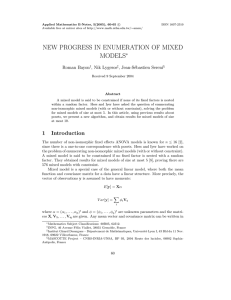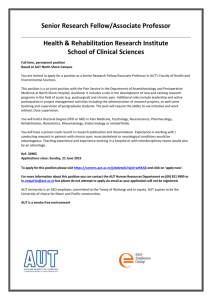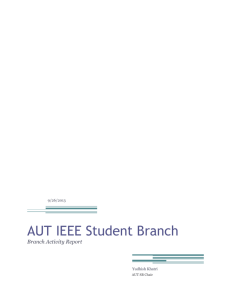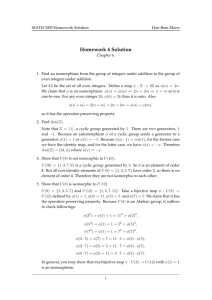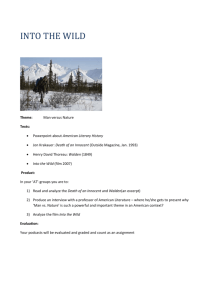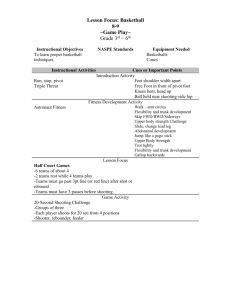The Hyperrings of Order 3 R. Bayon 14 av. du bosquet
advertisement
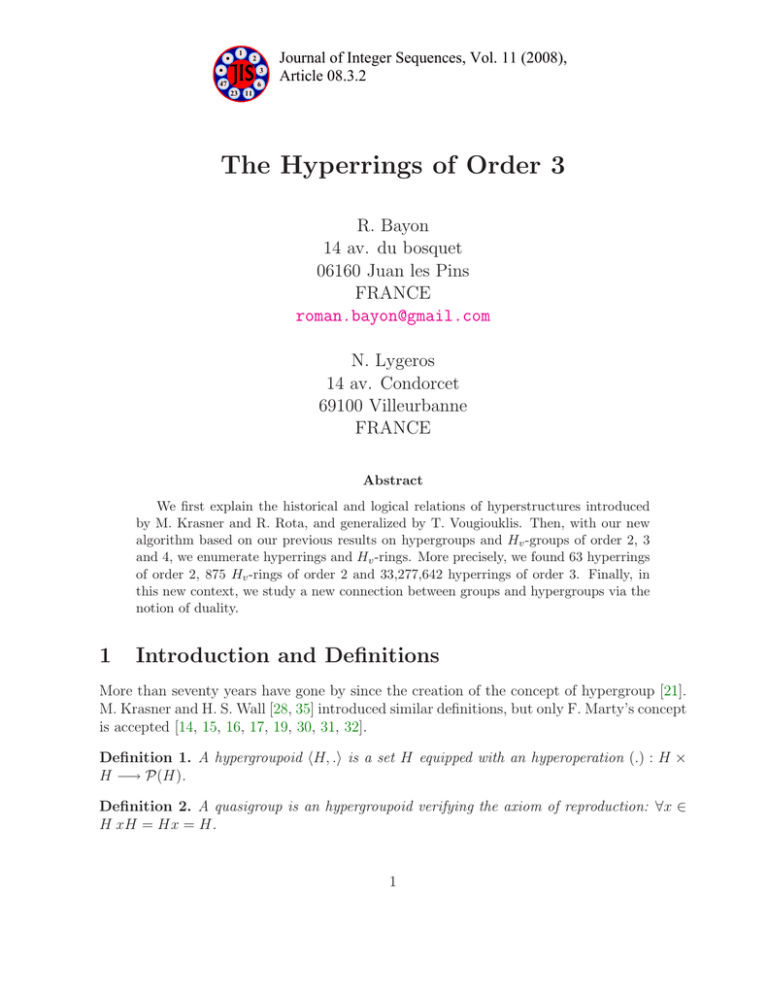
1
2
3
47
6
Journal of Integer Sequences, Vol. 11 (2008),
Article 08.3.2
23 11
The Hyperrings of Order 3
R. Bayon
14 av. du bosquet
06160 Juan les Pins
FRANCE
roman.bayon@gmail.com
N. Lygeros
14 av. Condorcet
69100 Villeurbanne
FRANCE
Abstract
We first explain the historical and logical relations of hyperstructures introduced
by M. Krasner and R. Rota, and generalized by T. Vougiouklis. Then, with our new
algorithm based on our previous results on hypergroups and Hv -groups of order 2, 3
and 4, we enumerate hyperrings and Hv -rings. More precisely, we found 63 hyperrings
of order 2, 875 Hv -rings of order 2 and 33,277,642 hyperrings of order 3. Finally, in
this new context, we study a new connection between groups and hypergroups via the
notion of duality.
1
Introduction and Definitions
More than seventy years have gone by since the creation of the concept of hypergroup [21].
M. Krasner and H. S. Wall [28, 35] introduced similar definitions, but only F. Marty’s concept
is accepted [14, 15, 16, 17, 19, 30, 31, 32].
Definition 1. A hypergroupoid hH, .i is a set H equipped with an hyperoperation (.) : H ×
H −→ P(H).
Definition 2. A quasigroup is an hypergroupoid verifying the axiom of reproduction: ∀x ∈
H xH = Hx = H.
1
Definition 3. A semigroup is an hypergroupoid verifying associativity: ∀x, y, z ∈ H x(yz) =
(xy)z.
Definition 4 (F. Marty [21, 22, 23]). A hypergroup hH, .i is a quasigroup verifying associativity: ∀x, y, z ∈ H x(yz) = (xy)z.
In 1991 T. Vougiouklis generalized the definition of F. Marty by weakening associativity
[30].
Definition 5. A hyperoperation is weakly associative if for any x, y, z ∈ H, x(yz)∩(xy)z 6= ∅.
Definition 6 (T. Vougiouklis [30]). hH, .i is a Hv -group if (.) : H × H → p(H) is a weakly
associative hyperoperation for which the reproduction axiom hH = Hh = H is valid for any
h of H.
The essential idea which governs the existence of these Hv -groups is a weaken associativity. This weakening simply consists in considering the two terms of the associative law as
sets, since this is possible, and in requiring that their intersection shall not be empty.
The Hv -groups have a property of which the hypergroups are deprived. This one is built
from the definition of the following partial order.
Definition 7 (T. Vougiouklis [31]). Let hH, .i and hH, ∗i two Hv -groups. We say that (.)
is less or equal than (∗), and note ≤, if and only if there exists f ∈ Aut(H, ∗) such that
xy ⊆ f (x ∗ y) for any x, y of H.
From this definition we can deduce the following theorem:
Theorem 8 (T. Vougiouklis [31]). If a hyperoperation is weakly associative, then any hyperoperation superior to it and defined on the same set is weakly associative too.
From this property, we can show the concept of minimality in a natural way.
Definition 9 (T. Vougiouklis [30]). (R, +, .) A hyperstructure is called a hyperring if (R, +)
is a hypergroup, (R, .) is a semigroup and (.) is distributive in respect to (+).
Definition 10 (S. Spartalis, A. Dramalides and T. Vougiouklis [29]). (R, +, .) A hyperstructure is called an Hv -ring if (R, +) is an Hv -group, (R, .) is a weak semigroup and (.) is weakly
distributive in respect to (+).
A. Dramalidis enumerated a restricted class
of Hv -rings, the dual Hv -rings.
Definition 11 (A. Dramalidis [16]). An Hv -ring (R, +, .) is dual if (R, ., +) is an Hv -ring.
He classified all Hv -ring such that R = {0, 1, a} where 0 is the scalar unit of Hv -group
(R, +) and absorbing element of semi-hypergroup (H, .) and 1 is the scalar unit of semihypergroup (H, .). In the same way, he classified all hyperannoids, where (.) is not distributive in respect to (+). He needed to avoid a maximum of computations because they
were done case-by-case. So he tried to minimize the role of associativity because of its high
computational cost and use the symmetry of duality.
2
We enumerate hyperrings and Hv -rings of small orders and this will probably improve
our understanding of the hyperannoids [6]. Indeed certain categories of hypergroups were
studied because of their low computational cost, but they were useless for the understanding
of hyperstructures. Our research [4, 2] already showed the greater importance of cyclic and
single-power hypergroups than the canonical hypergroups [25, 26].
From an historical point of view, M. Krasner introduced the notion of hyperring in 1966,
ten years after the notion of hyperfield. So the hyperring in M. Krasner’s sense generalizes
his notion of hyperfield. This one was considered as the natural extension of F. Martys’s
hypergroups. But this extension is not as natural as it seems. In order to avoid technical
problems, Krasner used ad hoc properties which were studied by his disciple J. Mittas.
Mittas introduced canonical hypergroups which are, in short, a restriction of hyperring and
consequently of hyperfield in Krasner’s sense. This global schema seemed complete and
closed, but in fact was not. The radically different approach of T. Vougiouklis showed this
critical point. T. Vougiouklis started his work by weakening associativity in the hypergroup
of Marty. It was then easy to extend this notion to hyperring and to hyperfield in a natural
way. Moreover, this approach generalizes Krasner’s and Rota’s approaches. Vougiouklis
does not work in a specific case as canonical hypergroups. His approach is based on the
hypergroup in Marty’s sense and moreover, he introduces Hv -groups. He avoids the pitfall
of representativity in the world of hypergroups. Indeed in our research, we show the low
importance of canonical hypergroups in the set of hypergroups. From this observation, we
easily deduce that M. Krasner’s generalization of hyperrings and hyperfields are analogous
in the corresponding world. So the generalization of Vougiouklis embraces the whole set of
hyperstructures.
2
Enumeration
In enumeration theory we have already obtained some results in different fields (see [8, 9,
11, 12, 18, 20] and A108089, A132590.
In our previous work we enumerate and classify the hypergroups of order 3 [3, 4] and
abelian hypergroups of order 4 [5] with Birkhoff’s point of view [10]. We then study the Hv groups of order 3 [7], and abelian Hv -groups of order 4 with Marty-Moufang hypergroups
[1].
Thanks to these enumerative results we can characterize some hyperstructures, as shown
with rigid hyperstructures or with hypocomplete hypergroups [4]. The obtained results
contribute consequently to validate our algorithm. We could also confirm the results of R.
Migliorati [24], some results of S-C. Chung and B-M Choi [13] and results of T. Vougiouklis
[33, 34] too. Now we present the best computational results in these fields A132591.
Theorem 12 (G. Nordo [27]). There are 3,999 isomorphism classes of hypergroups of order
3.
We give a more precise presentation with the classification of hypergroups by projectivity
and cyclicity (see table 1).
3
Classes of isomorphism
Abelians
non Abelians
non Cyclics
non Cyclics
Cyclics
Cyclics
Proj. non Proj.
Proj. non Proj.
1
4
2
2
3
6
1
|Aut(H)|
3
70
3
5
154
8
4
6
360
2
17
3279
20
61
Table 1: Classification of Hypergroups of Order 3
Theorem 13 (R. Bayon & N. Lygeros [7]). There are 20 isomorphism classes of Hv -groups
of order 2 (see table 2), ∗ indicates hypergroups).
Hv -group
(a; b; b; a)∗
(H; b; b; a)
(a; H; b; a)
(a; b; H; a)
(H; a; a; b)∗
(H; H; b; a)
(H; b; H; a)
(a; H; H; a)
(b; H; H; a)
(H; H; a; b)∗
|Aut(Hv )|
2
2
2
2
2
2
2
2
1
2
Hv -group
(H; a; H; b)∗
(a; H; H; b)∗
(H; a; a; H)
(H; b; a; H)
(H; a; b; H)
(H; H; H; a)∗
(H; H; H; b)∗
(H; H; a; H)
(H; H; b; H)
(H; H; H; H)∗
|Aut(Hv )|
2
1
2
1
1
2
2
2
2
1
Table 2: Hv -groups of Order 2 (H = {a, b})
Theorem 14 (R. Bayon & N. Lygeros [7]). There are 1,026,462 isomorphism classes of
Hv -groups of order 3 (see table 3).
|Aut(Hv )|
Classes of isomorphism
Abelian
non Abelians
non Cyclics
non Cyclics
Cyclics
Cyclics
Proj. non Proj.
Proj. non Proj.
1
5
2
4
2
2
8
1
1
47
5
7
3
243
8
14
2034
66
76
6
7439
10
195
1003818 1083
11394
Table 3: Classification of Hv -groups of Order 3
4
3
Hyperrings
A natural approach to hyperrings is to construct them from their underlying hyperstructures.
With this manner, we can easily check intermediate results. Consequently, we use the enumeration of hypergroups, semi-hypergroups, Hv -groups and Sv -groups (which are analogue
of Hv -groups for semi-hypergroups).
Fact 1 (R. Bayon & N. Lygeros). Let (R, +, .) be a hyperring then Aut(R) = Aut(+)∪Aut(.).
Corollary 15 (R. Bayon & N. Lygeros). Let (R, +, .) be a hyperring then |Aut(R)| ≥
max(|Aut(+)|, |Aut(.)|).
Theorem 16 (R. Bayon & N. Lygeros). There are 63 isomorphism classes of hyperrings of
order 2 (see table 4).
1
|Aut(R)|
2
Classes
6
114
Table 4: Classification of Hyperrings of Order 2
Theorem 17 (R. Bayon & N. Lygeros). There are 875 isomorphism classes of Hv -rings of
order 2 (see table 5).
Classes
1
33
|Aut(R)|
2
1684
Table 5: Classification of Hv -rings of Order 2
Theorem 18 (R. Bayon & N. Lygeros). There are 33,277,642 isomorphism classes of hyperrings of order 3 (see Table 6).
Classes
31
506
67,857
199,528,434
1
2
|Aut(R)|
3
6
Table 6: Classification of Hyperrings of Order 3
This global approach generalize the partial results obtained by T. Vougiouklis and A.
Dramalidis [16, 31].
5
3.1
Algorithm
We generate all the simple hyperstructures (hypergroups, semigroups, Hv -groups,... ) and
for each of them we compute the order of its automorphisms group. The number of hyperstructures, up to isomorphism, p is:
n!
X
si
p=
i
i=1
where n is the order of the hyperstructures, and si is the number of hyperstructures having
an automorphisms group of order i.
The algorithm for hyperrings is a natural extension of this one. We generate all simple
hyperstructures and check distributivity for each valid pair of hyperstructures. If the hyperringoid verifies distributivity, we compute and we store the order of their automorphisms
group. As all paires have been checked, we determine the number of hyperrings, up to
isomorphism.
4
Remarks on the notion of the dual of a group
Our research on the notion of the dual of a group is leaded by the program of M. Mizony. We
want to establish a structural link between groups and hypergroups. The dual of a group G,
denoted Ĝ is the set of characters which are morphism from the group to the multiplicative
group C∗ . So Ĝ is a group for product of morphism. If G is a finite group of order n then
the elements of Ĝ are the morphisms from G to the group of the nth root of unity.
2νx
For the cyclic group Z/pZ if we denote ω = e p , with i ∈ {0, . . . , n − 1}, all the elements
of Ĝ are written:
χ i : G → C∗
x 7→ (ω i )x = e
2νxi
p
We have G ∼
from G to C, vector
= Ĝ and Ĝ is an orthogonal basis
P of E ¯the set of functions
¯ is the conjugate of f (x)),
space with an Hermitian product: hf, gi = x∈G f (x).g(x)
(f (x)
and we know that this product definition is important for classical hypergroups. It is a way
to catch hyperrings in the sense of F. Marty. It is possible resolve an more generic case, the
one of abelian finite group. In this case, the dual of G is an orthogonal basis of E too. We
can observe it by considering the decomposition of Z-modules:
G∼
= Z/p1 Z × . . . × Z/pr Z
But this kind of approach is not possible in the non-abelian case. To see this, we can
study the symmetric group of order n. Indeed, by choosing two specific transpositions and
combining them to have a permutation, we obtain only two characters. This problem in
classical group theory is an opening to the theory of hypergroups.
Acknowledgements
We would thank Nikos Antampoyfis who provided us some useful references.
6
References
[1] R. Bayon and N. Lygeros. The Hv -groups and Marty-Moufang hypergroups. In Proceedings of First International Conference on Algebraic Informatics, pp. 285–294. Aristotle
University of Thessaloniki, 2005.
[2] R. Bayon and N. Lygeros. Advanced results in enumeration of hyperstructures. Journal
of Algebra, 320 (2008), 821–835.
[3] R. Bayon and N. Lygeros. Les hypergroupes d’ordre 3. Italian J. Pure Appl. Math., 20
(2006), 223–236.
[4] R. Bayon and N. Lygeros. Catégories spécifiques d’hypergroupes d’ordre 3. In Eléments
structurels de la théorie des hyperstructures: Colloque de l’Université de Thrace, March
2005.
[5] R. Bayon and N. Lygeros. Les hypergroupes abéliens d’ordre 4. In Eléments structurels
de la théorie des hyperstructures: Colloque de l’Université de Thrace, march 2005.
[6] R. Bayon and N. Lygeros. Hyperstructures and automorphism groups. Submitted.
[7] R. Bayon and N. Lygeros. Les hypergroupes et Hv -groupes d’ordre 3. Bull. Greek Math.
Soc., to appear, 2008.
[8] R. Bayon, N. Lygeros, and J.-S. Sereni. Nouveaux progrès dans l’énumération des
modèles mixtes. In Knowledge discovery and discrete mathematics: JIM’2003, pages
243–246, Université de Metz, France, 2003. INRIA.
[9] R. Bayon, N. Lygeros, and J.-S. Sereni. New progress in enumeration of mixed models.
Appl. Math. E-Notes, 5 (2005), 60–65.
[10] G. Birkhoff. Sobre los grupos de automorphimos. Revista Union Math. Arg, 11 (1946),
155–157.
[11] C. Chaunier and N. Lygeros. The number of orders with thirteen elements. Order, 9
(3) (1992), 203–204.
[12] C. Chaunier and N. Lygeros. Le nombre de posets à isomorphie près ayant 12 éléments.
Theoret. Comput. Sci., 123 (1994), 89–94.
[13] S-C. Chung and B-M Choi. Hv -groups on the set {e, a, b}. Italian J. Pure Appl. Math.,
10 (2001), 133–140.
[14] P. Corsini. Prolegomena of Hypergroup Theory. Aviani Editore, 1993.
[15] P. Corsini and V. Leoreanu. Applications of Hyperstructure Theory. Kluwer Academic
Publishers, 2003.
[16] A. Dramalidis. Dual Hv -rings. Riv. Math. Pura Appl., 17 (1995), 55–62.
7
[17] A. Dramalidis. Geometrical - Algebraic Hyperstructures and Their Instructional Approach. PhD thesis, in Greek, 1995.
[18] R. Fraı̈ssé and N. Lygeros. Petits posets: dénombrement, représentabilité par cercles et
“compenseurs”. C. R. Acad. Sci. Paris Sér. I Math., 313 (7) (1991), 417–420.
[19] M. Kuntzmann. Opérations multiformes. hypergroupes. C. R. Acad. Sci. Paris Math.,
204 (1937), 1787–1788.
[20] N. Lygeros, P.V. Marchand, and M. Massot. Enumeration and 3d-representation of the
stereo-isomers of paraffinic molecules. J. Symbolic Computation, 40 (2005), 1225–1241.
[21] F. Marty. Sur une généralisation de la notion de groupe.
Mathématiciens Scandinaves, Stockholm, pp. 45–49, 1934.
In 8ème congrès des
[22] F. Marty. Rôle de la notion d’hypergroupe dans l’étude des groupes non abéliens. C.
R. Acad. Sci. Paris Math., 201 (1935), 636-638.
[23] F. Marty. Sur les groupes et hypergroupes attachés à une fraction rationnelle. Annales
scientifiques de l’E.N.S., 53 (1936), 83–123.
[24] R. Migliorato. Ipergruppi di cardinalità 3 e isomorfismi di ipergruppoidi commutativi
totalmente regolari. Atti Convegno su Ipergruppi, altre Strutture Multivoche e loro
applicazioni, Udine, 1985.
[25] J. Mittas. Hypergroupes canoniques. Math. Balkanica, 2 (1972), 165–179.
[26] J. Mittas. Hypergroupes renaissants. Atti Sem. Mat. Fis. Un. Modena, 33 (1984),
319–328.
[27] G. Nordo. An algorithm on number of isomorphism classes of hypergroups of order 3.
Italian J. Pure Appl. Math., No. 2 (1997), 37–42.
[28] P. Ribenboim. Il mondo Krasneriano. Queen’s Mathematical Preprint, No. 1983-12,
158 pp., 1983.
[29] S. Spartalis, A. Dramalides, and T. Vougiouklis. On Hv -group rings. Algebras, Groups,
and Geometries, 15 (1988), 47–54.
[30] T. Vougiouklis. The fundamental relation in hyperrings. The general hyperfield. In
Algebraic Hyperstructures and Applications (Xánthi, 1990), World Scientific Press, 1991,
p. 203–211.
[31] T. Vougiouklis. Hyperstructures and their Representations. Hadronic Press, 1994.
[32] T. Vougiouklis. A new class of hyperstructures. J. Combin. Inform. System Sci. 20
(1995), 229–235.
[33] T. Vougiouklis. Hv -groups defined on the same set. Discrete Math., 155 (1996), 259–265.
8
[34] T. Vougiouklis, S. Spartalis, and M. Kessoglides. Weak hyperstructures on small sets.
Ratio Math., 12 (1997), 90–96.
[35] H. S. Wall. Hypergroups. American J. Math., 59 (1937), 78–98.
2000 Mathematics Subject Classification: Primary 20N20.
Keywords: Automorphism groups, Hypergroups, Hyperrings, Hyperstructures, Hv -groups.
(Concerned with sequences A108089, A132590, and A132591.)
Received September 9 2007; revised July 25 2008. Published in Journal of Integer Sequences,
August 1 2008.
Return to Journal of Integer Sequences home page.
9
